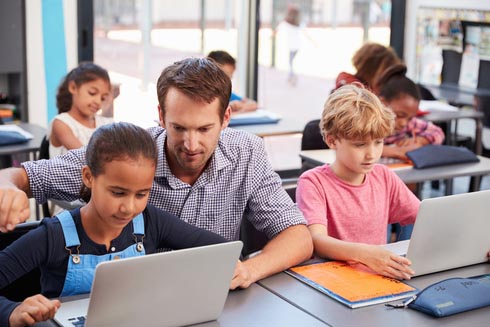(单词翻译:单击)
听力文本
Study Finds Educators, Students Agree: Technology Has Value
Technology is widely available to students in classrooms across the United States, a new study shows.
The study comes from the non-profit NewSchools Venture Fund and Gallup, a company best known for its public opinion surveys. It found that nearly nine in 10 U.S. public school students say they use digital learning tools at least a few days a week. And more than half of those questioned said they use digital technology to learn every day.
In the new survey, digital learning tools means technology. It includes websites, application software programs, and online classes, games, videos and programs.
The survey found that classroom technology gets high marks from educators. At least eight in 10 teachers and school administrators said they see great value in using classroom technology tools now and in the future.
A report on the survey and its findings was released earlier this month. It is called Education Technology Use in Schools.
Researchers questioned thousands of U.S. public school teachers and students, school principals and school district administrators. The educators work in schools with classes from pre-kindergarten through 12th grade.
The report found that across the country, digital learning "is everywhere and it's very integral to learning," Tonika Cheek Clayton told VOA. She is managing partner at NewSchools. The fund connects businesses with donors to finance new education technology programs.
Clayton says that most U.S. teachers – 65 percent -- use digital tools to teach every day. She adds that more than three fourths of teachers said the technology helps to improve their effectiveness in the classroom. Educators think it is especially effective in activities like research, information searches, reports and presentations.
When it comes to preparing students for future employment and careers, the study found that educators are likely to say technology is more effective than non-digital tools for connecting learning to students' careers.
Derek Kelley of Virginia agrees. He coordinates technology for Fairfax County Public Schools, which serves nearly 200,000 students. He told VOA, "the important thing is to help prepare the students for real world experience" and knowledge about technology is something students need.
Kelley said technology is just one of many tools available to teachers. Because students learn differently, technology can help teachers support their students by offering different methods for providing information.

"Traditional teaching where the teachers (are) standing up, versus the role of technology in a classroom, I think both are important," Kelley said. "And I think there needs to be balance."
In the report, more than half of the special education teachers questioned said technology can help their students.
Tony Daniel, a special education teacher, agrees with that. He teaches children with learning difficulties at the Springfield Estates Elementary School in Springfield, Virginia.
Daniel says he uses technology tools "as a way to extend learning and really enhance how the kids are learning to give them a more hands-on experience."
Daniel helps his students learn and do computer coding in class. At times, some of his students like using a pencil and paper, while others want to use technology. He said they have to be taught how to use technology.
"You really have to think about if that student's needs are being met and not just you know, giving everyone a tablet," he said.
Critics of technology in classrooms say that students are spending too much time looking at screens on their computers or electronic devices.
Concerns about technology overuse is something Derek Kelley's office hears about from the community. "So we are making sure that there is a balance with student use of technology," he says.
Tonika Cheeck Clayton said what is important is that nearly all of the teachers -- 90 percent -- limit technology use to less than half of the class time. That was true even for those who use technology every day.
Nearly all elementary students say digital learning tools are fun. Most say the technology helps them learn things on their own and at their own speed.
Almost three-fourths of secondary students say the technology tools help them learn things on their own. Over half said they make school more interesting. Forty-two percent would like to use it more often at school, and only eight percent said they would like to use them less.
One thing everyone agrees on: technology is here to stay in American classrooms.
I'm Anne Ball. And I'm Bryan Lynn
重点解析
重点讲解:
1. be available to 可被......利用或得到的;可提供给;
The arts should be available to more people at prices they can afford.
他们站在小山之巅,饱览这花园城市的美景。
2. be integral to 对......是不可或缺的;
The command and control must be integral to the architecture and the code developed.
为了把活儿干完,彭妮常常午饭时间也要工作。
3. agree with 适合;赞同;
I don't agree with you at all.
我压根儿就不赞成你的主张。
4. at times 有时;时常;
The match took nearly three hours and was interrupted at times by rain.
比赛进行了将近3个小时,几次因雨而暂停。
参考译文
研究发现教育者和学生均同意:科技在教学中具有价值
一项新的研究显示,美国各地的学生都在广泛运用科技。
这项研究来自非盈利性组织新闻学校风险基金会,和以实施民意调查而闻名的盖洛普咨询公司。研究发现,近九成的美国公立学校学生表示,他们每周至少有几天会使用数字化学习工具。超过一半的被调查者说,他们每天都借助数字技术来学习。
在新的调查中,数字学习工具意味着技术性设备,包括网站、应用软件程序、在线课程、游戏、视频和程序。
调查发现,教育工作者给课堂技术打出了高分。至少有十分之八的教师和学校管理者表示,他们认为现在以及未来使用课堂技术工具很有价值。
本月早些时候公布了一项调查报告结果,其名称为学校教育中的技术应用。
研究人员询问了数千名美国公立学校的师生、校长和学区管理人员,教育工作者工作于从幼儿园学前班到12年级各年级的老师。
新闻学校风险基金会合伙人托尼卡·奇克·克莱顿告诉美国之音的记者,报告发现,在全国范围内,数字化学习“无处不在,它对学习非常重要”。该基金会将企业与捐赠者联系起来,资助新型教育技术项目。
克莱顿说,大多数美国教师(65%)每天都使用数字化工具授课。她补充说,超过四分之三的教师说,这些技术有助于提高他们在课堂上的效率。教育工作者认为,技术在研究、信息搜索、报告和演示等活动中都特别有效。
当谈到让学生为将来的就业和职业生涯做准备时,研究发现,教育者可能会说,技术比非数字化工具能更有效地将学习与学生的职业生涯联系起来。
负责弗吉尼亚州费尔法克斯县公立学校技术协调工作的德里克·凯利也表示同意,该校为近20万名学生提供服务。他告诉美国之音,“重要的是帮助学生为应对真实世界做好准备”,学生们需要知道有关技术的知识。
凯利说,技术只是教师可以使用的众多工具之一。由于学生的学习方式不同,技术可以借助不同的信息提供方式来帮助教师支持学生。
凯利说:“传统教学中,教师站着讲课,与课堂上运用的技术相比,我认为两者都很重要,需要达到平衡。”
在这份报告中,超过一半的受访特殊教育教师都表示,技术可以帮助他们的学生。
特殊教育教师托尼·丹尼尔表示,他同意这一点。他在弗吉尼亚州斯普林菲尔德的斯普林菲尔德庄园小学教有学习困难的孩子。
丹尼尔说,他使用技术工具“作为一种扩展学习的方式,真正提高孩子们的学习方式,让他们更多地进行亲身体验。”
丹尼尔在课堂上帮助他的学生学习和进行电脑编码。有时,一些学生喜欢用纸笔,而另一些学生则想采用技术化工具。他说,必须教会他们如何使用这些技术。
他说:“你必须要考虑到,学生的需求是否得到了满足,而不是仅仅发给每人一个平板电脑。”
对教室技术持有批评态度的人士表示,学生盯着电脑或电子设备屏幕的时间过长。
德里克·凯利办公室的人员从社区中了解到,人们对技术过度使用表示出担忧。“因此,我们正在确保学生在使用技术时达到一个平衡点,”他说。
托尼卡·奇克·克莱顿说,最重要的是,几乎所有的老师(90%)都把采用技术化工具限制在不到半堂课的时间,即使是那些每天运用科技教学的老师也是如此。
几乎所有的小学生都说,数字化学习工具很有趣。大多数学生表示,这些技术帮助他们以自己的速度自主学习。
将近四分之三的中学生说,这些技术化工具帮助他们自学。超过一半的学生说,技术化工具让学校变得更为有趣。42%的学生愿意在学校更多的使用技术化工具,只有8%的人想少用这些工具。
有一件事得到了大家的一致认可,那就是在美国的教室中将一直运用技术化工具。
安妮·鲍尔和布莱恩·林恩报道。
译文为可可英语翻译,未经授权请勿转载!


